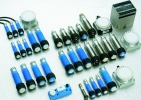

Proximity switches, capacitive and photoelectric sensors are capable of detecting objects within fixed distances. However, these measurements are depending on surface structure, colour and material of the objects.
The ultrasonic proximity sensors from PIL have been developed to overcome such restrictions in applications. Also the majority of requirements to measuring distance can be met.
The sensors use an ultrasonic transducer to send and receive sound waves. Specially coded ultrasonic signals are transmitted in a set pattern. After being reflected from the object to be measured, the signals are received by the sensor and decoded. The recorded time of flight is temperature compensated and converted to distance data.
PIL has developed its product series P42, P44 and P47, a broad range of non-contact proximity sensors, optimised for varied applications.
PIL ultrasonic sensors offer high resolution, optimum precision, long detection range, very short minimum distance, long range, and IP67.
Analogue digital standard switching outputs or RS232- and RS485-interfaces allow further connection to a PC. Several sensors can be used at the same time via synchronising devices as a result of which it is possible to scan structures with sensor arrays.
Technological parameters
Almost all sound reflecting materials can be detected. Even sound absorbing materials such as wadding or rubber foam can be detected with reduction of the maximum sensing range. Detection is independent of the form of the object, it can be solid, liquid or even powder.
A signficant advantage is the ability to detect transparent objects with ultrasonic sensors.
Maximum sensing range is determined by the level of ultrasonic sound reflected from the object.
Measurement range
The measurement range is defined by the maximum and the minimum measurement distance. In close proximity the transit time of the sound pulse cannot be clearly measured.
Measurement rate
Only when the pulse echo has again reached the ultrasonic transducer and after this has decayed can a new pulse be transmitted. Therefore, ultrasonic sensors with large measurement distances have low measurement rates and ultrasonic sensors with small measurement distances high measurement rates.
Minimum distance
Ultrasonic sensors are using a single transducer for transmitting and receiving of the ultrasonic pulse. Because the transducer cannot carry out both processes simultaneously, a zone in front of the sensor is created, in which the position of a target cannot be determined.
The maximum is the distance in which a sufficient echo can be received by the transducer.
Environmental influences such as humidity, dust and smoke do not affect the precision of measurement.
Strong air movement and turbulence lead to instability in the measurement. Air stream speeds up to several m/s can nevertheless be handled so that nothing prevents use in the open air.
Ultrasonic sensors can be fitted in any desired position as long as physical contact with the active sound surface is prevented. The ultrasonic beam can also be re-directed by reflectors but this will reduce the maximum distance. Concentration of the sound beam is possible with a focusing reflector.

© Technews Publishing (Pty) Ltd | All Rights Reserved